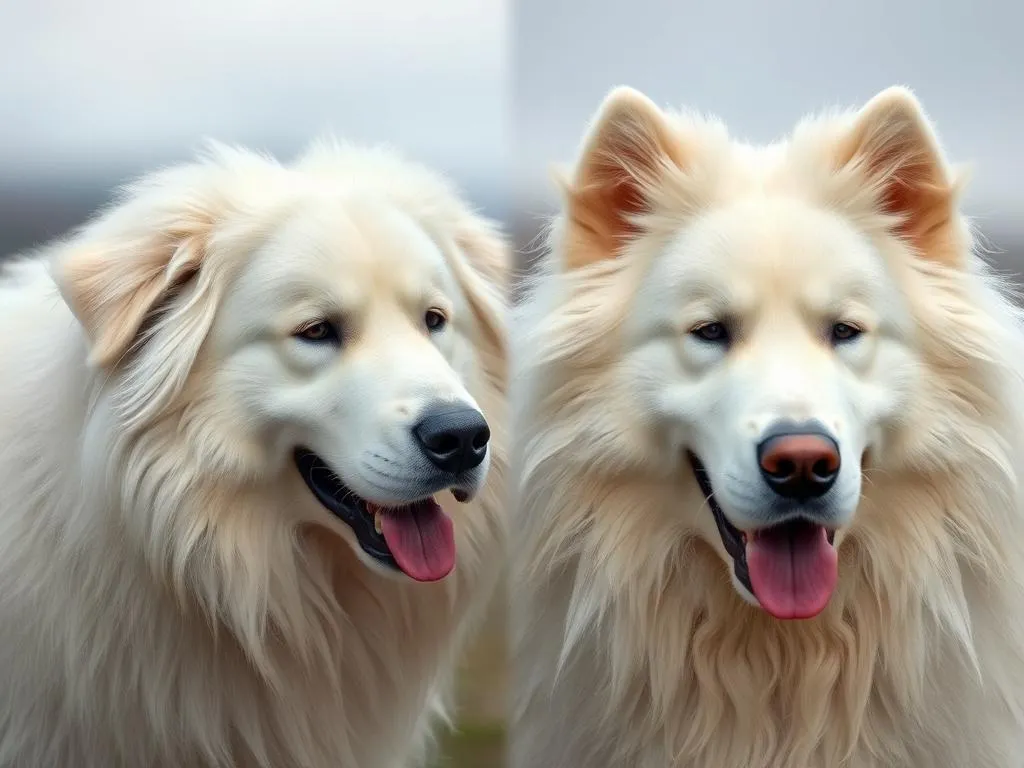
Both the Great Pyrenees and Samoyed are cherished breeds known for their unique characteristics and loyal dispositions. Choosing the right dog breed is crucial for potential owners, especially when considering lifestyle, family dynamics, and specific breed traits. This guide will delve into the backgrounds, temperaments, training needs, exercise requirements, grooming, health considerations, living environments, and financial aspects of both breeds to assist in your decision-making process.
Background of the Breeds
Great Pyrenees
The Great Pyrenees has a rich history that dates back thousands of years to the mountainous regions of France and Spain. Originally bred to guard livestock, these dogs were essential for protecting sheep from predators in the Pyrenees mountains. Their impressive size and strength made them formidable guardians, while their calm demeanor allowed them to work well with both livestock and humans.
Physically, the Great Pyrenees is a large breed, typically weighing between 85 to 115 pounds. They possess a thick, double coat that is predominantly white, with shades of tan or gray sometimes appearing. Their large, expressive eyes and gentle demeanor give them a majestic appearance that captivates many dog lovers.
Samoyed
The Samoyed originates from Siberia, where it was developed by the Samoyedic people as a versatile working dog. This breed was primarily used for herding reindeer, pulling sleds, and providing companionship to nomadic tribes. The Samoyed’s friendly disposition and strong work ethic made them invaluable to their human counterparts.
Samoyeds are medium to large-sized dogs, typically weighing between 35 to 65 pounds. They are recognizable for their fluffy white coat, which helps them withstand harsh Arctic climates. Their signature “Sammy smile,” characterized by a slight upward curve of their lips, contributes to their friendly and approachable appearance.
Temperament and Personality
Great Pyrenees Temperament
The Great Pyrenees is known for its calm and protective nature. These gentle giants are incredibly loyal to their families and often form strong bonds with children. Their instinctual guarding abilities make them excellent protectors, but they are also affectionate and enjoy spending time with their loved ones.
Socialization is vital for the Great Pyrenees, as they can be reserved around strangers. Early exposure to various environments, people, and other animals is essential to ensure they grow into well-rounded adults. While they are generally not aggressive, their strong instincts may lead them to be wary of unfamiliar situations.
Samoyed Temperament
In contrast, the Samoyed is known for its friendly, playful, and social temperament. They are often described as “people-oriented” and thrive on human interaction. Samoyeds are good with children and tend to get along well with other pets, making them excellent family companions.
Despite their friendly nature, Samoyeds require proper socialization to prevent them from becoming overly excitable with strangers. Their playful demeanor can sometimes be mistaken for hyperactivity, but with proper training and exercise, they can channel their energy effectively.
Training and Intelligence
Training the Great Pyrenees
Training a Great Pyrenees can be a rewarding yet challenging experience. While they are intelligent dogs, their independent nature means they may not always be eager to please. Positive reinforcement methods, such as treats and praise, work best to motivate them.
To train a Great Pyrenees effectively, consistency and patience are key. Short, engaging training sessions are recommended to hold their attention. Early obedience training is crucial, as is exposure to various environments and situations.
Common challenges include their stubbornness and potential for distraction. However, with persistence and positive reinforcement, these challenges can be overcome.
Training the Samoyed
The Samoyed is generally more eager to please and can be easier to train than the Great Pyrenees. They are intelligent and quick learners, but their playful nature can sometimes lead to a lack of focus during training sessions.
Using positive reinforcement techniques, such as rewards and play, can make training enjoyable for both the dog and the owner. Socialization should start early, exposing them to different environments, people, and other dogs to ensure they develop into well-adjusted adults.
Common challenges with Samoyeds include their strong prey drive and tendency to be mischievous. Engaging them in mentally stimulating activities can help channel their energy and reduce unwanted behaviors.
Exercise and Activity Requirements
Exercise Needs of the Great Pyrenees
The Great Pyrenees is a relatively low-energy breed, but they do require daily exercise to maintain their health and well-being. Ideally, they should have at least 30 to 60 minutes of moderate exercise each day, which can include leisurely walks, playtime in a secure yard, or even light hiking.
Mental stimulation is equally important for this breed. Activities such as puzzle toys or scent work can help keep their minds engaged. While they enjoy outdoor activities, they are not as demanding as some other breeds in terms of exercise.
Exercise Needs of the Samoyed
In contrast, the Samoyed is a more active breed that requires substantial exercise to stay healthy and happy. They thrive on physical activity and should engage in at least 60 to 120 minutes of exercise each day. Activities can include long walks, runs, playing fetch, or participating in dog sports such as agility.
Mental stimulation is also critical for Samoyeds. They enjoy interactive toys and games that challenge their problem-solving abilities. Regular exercise not only helps them release energy but also prevents boredom and associated behavior issues.
Grooming and Maintenance
Grooming the Great Pyrenees
The Great Pyrenees has a thick double coat that requires regular grooming. They shed moderately year-round, with heavier shedding occurring during seasonal changes. To keep their coat healthy and reduce shedding, grooming sessions should occur at least once a week, with more frequent brushing during shedding seasons.
Bathing should be done as needed, typically no more than once every few months to avoid stripping their coat of natural oils. Regular checks for matting, especially around the ears and undercarriage, are essential. Additionally, routine nail trimming and dental care should not be overlooked.
Grooming the Samoyed
The Samoyed is known for its beautiful, fluffy coat that requires diligent grooming to maintain. They shed heavily, particularly during seasonal changes, and should be brushed at least two to three times a week. During shedding seasons, daily brushing may be necessary to prevent matting and keep their coat healthy.
Bathing should also be done as needed, generally every few months, unless they get into something particularly messy. Just like the Great Pyrenees, regular dental care and nail trimming are essential for the overall health of the Samoyed.
Health Considerations
Common Health Issues in Great Pyrenees
The Great Pyrenees is generally a healthy breed, but they can be prone to certain genetic conditions. Common health issues include hip dysplasia, elbow dysplasia, and certain types of cancers. Regular veterinary check-ups and screenings are essential to catch any potential health problems early.
Preventative care, including a balanced diet and regular exercise, can help maintain their health. Responsible breeding practices can also reduce the risk of hereditary health issues.
Common Health Issues in Samoyeds
The Samoyed is also relatively healthy but is predisposed to specific health concerns. Common issues include hip dysplasia, progressive retinal atrophy (PRA), and skin conditions. Regular veterinary care and health screenings are recommended to monitor these potential issues.
A nutritious diet, regular exercise, and proper grooming can help prevent some health problems. Like the Great Pyrenees, choosing a reputable breeder who conducts health testing on breeding dogs is crucial for minimizing genetic risks.
Living Environment and Adaptability
Best Living Conditions for Great Pyrenees
The Great Pyrenees thrives in environments with ample space, such as homes with large yards. They are not suited for apartment living due to their size and need for outdoor space. Their thick coat also makes them more comfortable in cooler climates.
While they can adapt to various living conditions, they should have a secure area to roam and explore. A fenced yard is ideal to allow them to exercise safely.
Best Living Conditions for Samoyeds
The Samoyed is equally suited for homes with ample space, but they can adapt better to different living conditions, including homes with smaller yards. They enjoy being part of family activities and thrive in environments where they receive plenty of social interaction.
Samoyeds are versatile and can tolerate various climates, but they prefer cooler temperatures due to their thick fur. Regardless of living conditions, they should have regular opportunities for outdoor exercise and play.
Cost of Ownership
Financial Considerations for Great Pyrenees
The initial purchase price for a Great Pyrenees can vary widely but generally ranges from $800 to $1,500, depending on the breeder’s reputation and location. Ongoing costs include food, grooming, and veterinary care, which can average around $1,000 to $2,000 per year.
Grooming costs can vary based on the frequency of professional grooming, while food expenses will depend on the quality of the diet chosen. Regular veterinary check-ups and preventative care are essential for maintaining their health.
Financial Considerations for Samoyeds
The Samoyed typically has a similar price range for initial purchase, usually between $800 to $2,000. Ongoing costs for this breed generally range from $1,000 to $2,500 per year, factoring in food, grooming, and veterinary care.
Grooming costs are significant for Samoyeds due to their high grooming needs, especially during shedding seasons. Food costs will also be influenced by the quality of the diet, and regular veterinary care is vital for their overall health.
Conclusion
In summary, both the Great Pyrenees and Samoyed are wonderful breeds with distinct traits that make them suitable for different owners. The Great Pyrenees is calm, protective, and better suited for quieter environments, while the Samoyed is friendly, playful, and thrives on social interaction.
When choosing between these two breeds, it’s essential to consider your lifestyle, family dynamics, and the time you can dedicate to training and exercise. Both breeds require commitment, but they also offer immense companionship and love in return. Take the time to reflect on your preferences and circumstances to ensure you make the right choice for you and your future furry friend.









